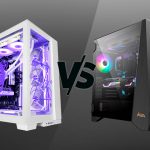What Is GPU Direct Storage?
GPU direct storage is exactly what it sounds like, it’s a software technology that allows your graphics card to communicate directly with your storage device through the PCIE switch. Traditionally, a graphics card has always had to make a request to the CPU which would then go through system ram to request assets and back again. In short, GPU direct storage removes a lot of steps from the process!

What advantages does GPU Direct Storage Offer?
The advantages of new GPU Direct Storage technology are multifold, the first and most readily apparent of which is that latency between transfers can be improved by almost two-fold. Additionally, Bandwidth is increased by two times as well. The storage interfacing directly with the GPU also reduces system memory and CPU usage as well.
In the world of gaming PCs these technical advantages translate into a couple of things. Much larger and more detailed textures and other assets can be used without fear of slowing the system down. Another great aspect is that thanks to assets being able to be transferred so quickly, the graphics memory does not need to retain as many assets consistently allowing for smaller frame buffers to be more effective than they ever have been. In other words, a graphics card that may be running out of it’s 6GB of video ram could fair much better in a game with GPU direct storage. The Only catch is that for the most optimal usage of the feature faster storage such as an NVME will be needed. While it still works with Traditional HDDs and SATA SSDs the benefits will not be as great.
When will we see this technology in gaming?
GPU direct storage is already implemented on the Xbox Series X/s as well as the PS5. Both Sony and Microsoft released these consoles from the get-go with this planned and was updated into both consoles APIs shortly after launch as they both have relatively small amounts of memory by today’s standards. The Series X/S as well as the PS5 have a total of 16gb of memory shared between the GPU and CPU (https://www.digitaltrends.com/gaming/xbox-series-x-vs-ps5/)
As of Mar 14th Microsoft made the API available on PC. The first PC game to have announced support for the tech is Square Enix’s Forespoken Shadow releasing in May, and we can expect a great many games to follow suit. With the console ecosystem going to force games to need this feature to function as they get more demanding in the coming years, it’s only natural that it’s going to become mainstream across all platforms and is a feature that will be here to stay.








No comments yet